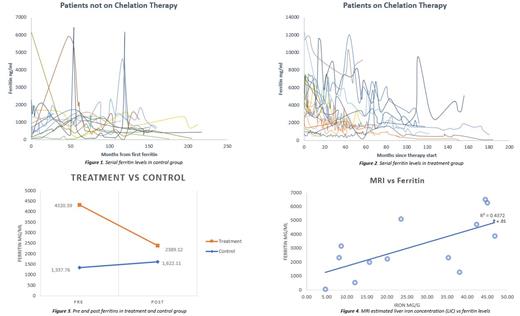Abstract
Iron (Fe) overload is not rare among sickle cell disease (SCD) patients. It results from either chronic transfusions for primary or secondary stroke prevention, or more commonly sporadic, mostly unnecessary transfusions and are associated with significant morbidity, secondary to hepatic, cardiac and renal Fe deposition. Previous studies at our Center showed that 12% of the adult SCD population had Fe overload, and vast majority of these (80%) resulted from episodic transfusions (Son et al, 2013). Subsequent studies showed that the Fe regulatory peptide, hepcidin was appropriately upregulated in SCD subjects with Fe overload, and the plasma levels of the glycoprotein hormone erythroferrone (ERFE) was not as high as that found in patients with transfusion dependent beta thalassemia (TDT) due to the absence of significant ineffective erythropoiesis in SCD (Thawer et al, 2017, Mangaonkar et al, Brit. J. Haematol, 2020). We report on the utilization and outcomes in Fe overloaded SCD patients who were prescribed the oral chelating agent deferasirox.
22 patients were prescribed deferasirox; median age was 38, 12 female 10 male. 21 had Hb SS, and 1 had s-b 0 thalassemia. Deferasirox dose ranged from 720-2500 mg/day (12 to 28 mg/Kg/day). Nonadherence was ascertained by patients' own admission. Figures 1-3 show the pre and post ferritin levels in subjects who were on deferasirox, and in controls; patients who took deferasirox had a more pronounced decrease in their ferritin (p=.004 vs p=.74). Although hepatic MRI for liver iron content (LIC) was not available on all patients, in those who underwent MRI there was a correlation between LIC and serum ferritin obtained at close temporal proximity (Fig. 4). Most common side effects of deferasirox were gastrointestinal (abdominal pain, nausea, vomiting, diarrhea), which were seen less commonly with the newer oral formulation (Jadenu).
Several conclusions can be drawn from our observation on relatively small number of patients: 1) Deferasirox is effective in decreasing Fe overload as shown by serum ferritin levels 2) Second generation of oral deferasirox is better tolerated, and therefore is associated with improved adherence, 3) Documentation of a decrease in LIC with chelation will be important for the reversal of Fe induced organ damage, and 4) Parallel studies of the levels of Fe regulatory peptides hepcidin and erythroferrone (ERFE) will clarify the effect of chelation therapy on biomarkers of Fe metabolism.
No relevant conflicts of interest to declare.


This feature is available to Subscribers Only
Sign In or Create an Account Close Modal